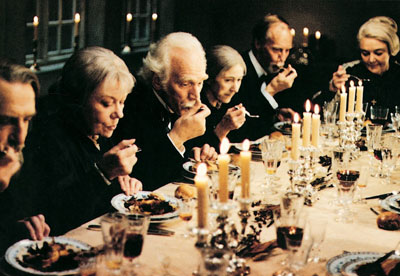Summary – French War refugee Babette works for 2 sisters & their ascetic sect. When she cooks a feast they reluctantly eat but soon the grace of the meal transforms all, including a former suitor of one of the sisters.

Babette’s Feast is a high regarded Danish Academy Award winning movie from 1987.
The setting of the film is a barren, windswept coastal village of Denmark in the 19th century. The village is populated by a very conservative and pious community of Protestant believers. It is led by two elderly sisters who struggle to maintain the faithfulness and the spirit of the community, which is aging and growing quarrelsome. When Babette, a political refugee from Paris, turns up in their village, the sisters charitably take her in and make her their housekeeper. They ask Babette to cook their very simple fare, for extravagance of any kind is suspect, and enjoyment of worldly pleasures (including lavish eating and drinking) is sinful.
For fourteen years the three women live together amicably. Fourteen years pass. The parishioners meet regularly for prayer and a meal at the sisters’ home. But their meals are as filled with grumbling and bickering as they are with prayers and hymns. They harbor resentments and grudges against each other for wrongs committed long ago. Interestingly, their bickering always stops when Babette enters the room to serve their simple meal. A disapproving glance or a clearing of her throat is enough to bring shame and silence. Her mere presence is a rebuke to unworthy words or thoughts.
Then Babette, quite astonishingly, receives a letter from a friend in Paris saying that she has won the Parisian lottery. She asks the sisters if she can use her winnings to prepare a feast for them, in thanks for all they have given her over the past fourteen years. They reluctantly agree.
What the sisters did not know was that prior to fleeing Paris, Babette had been a famous chef. With her lottery winnings she imports china and crystal, wines and rare foods, to prepare a dinner for the village as magnificent as the meals she made as a Parisian chef.
Initially the sisters and the townsfolk are reluctant to enjoy the feast. They fear it is indulgent and dangerous.
But as this meal progresses, it has an incredible effect on those present. This meal marked by stunning beauty, savory tastes, and lavish generosity elicits joy and laughter. Apologies are made around the table and old wounds are healed. Wonder is aroused at the breathtaking gifts of life.
The General, a suitor of one of the sisters can not contain himself by the end of the meal. He rises, clinks his spoon on his glass, and delivers an address on grace, the grace of God which transcends time and distance, and which “proclaims a general amnesty” to all. No longer is he a vain man parading his lofty position before Martine, the woman who had rejected him. He concludes by quoting Pastor’s favorite Psalm (85:5-10): “Mercy and truth have met together. Righteousness and bliss have kissed one another.”
For the villagers, Babette’s feast becomes an occasion of utter grace. Their cramped and worried hearts are opened to life’s goodness and God’s gifts, all because of the experience of a blessed, shared meal.
Babette’s life becomes an image of Christ as the banquet host. There are other similariteis
There are other similarities. Both Jesus and Babette fled to foreign countries. Jesus often called himself a servant, taking that role when he washed the feet of his disciples. Babette worked for fourteen years as an unpaid servant. Like Christ in St. Paul’s letter to the Philippians (2:6-8) Babette “emptied” herself. She forsook her culinary authority and allowed herself to be taught how to make a simple gruel, which she transformed into a worthy meal.
Most central to this film, however, is the theme of extravagant love and grace. Babette gives everything she has to deliver a group of people from their spare, colorless, and loveless, religion. She invites those who have chosen meagerness to a feast, to taste with joy the abundance of life. She transforms a little gathering of ascetics into an affair of beauty and splendor. As an image of Christ the Lover (and, we ought to add, Artist), she has wooed them out of the darkness and into the light of the Creator God’s presence.
See the trailer
